Hox Study guides, Class notes & Summaries
Looking for the best study guides, study notes and summaries about Hox? On this page you'll find 213 study documents about Hox.
Page 4 out of 213 results
Sort by
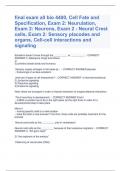
-
LATEST bio 4400, Cell Fate and Specification, Exam 2: Neurulation, Exam 2: Neurons, Exam 2 - Neural Crest cells, Exam 2: Sensory placodes and organs, Cell-cell interactions and signaling EXAM WITH ANSWERS
- Exam (elaborations) • 95 pages • 2024
-
- $14.49
- + learn more
Ectoderm doesn't move through the __________ or __________ - CORRECT ANSWER 1) blastopore (frogs and fishes) or 2) primitive streak (birds and humans) Sensory organs all begin in the head as... - CORRECT ANSWER placode - thickenings of surface ectoderm what are 4 types of cell interactions? - CORRECT ANSWER 1) Internal/mechanical 2) Juxtacrine signaling 3) Paracrine signaling 4) Endocrine signaling Note: these are arranged in order of closest interaction to longest distance interactio...

-
First Aid USMLE Step 1- Reproductive Organ Systems + Embryology
- Exam (elaborations) • 91 pages • 2023
- Available in package deal
-
- $7.99
- + learn more
First Aid USMLE Step 1- Reproductive Organ Systems + Embryology 2023 Update Sonic Hedgehog Gene - ANS-Produced @ base of limbs in zone of polarizing activity Involved in patterning along anterior/posterior axis *SUMMARY: Anterior/posterior pattern* Wnt-7 Gene - ANS-Produced @ apical ectodermal ridge (thickened ectoderm @ distal end of each developing limb) Necessary for organization along dorsal/ventral axis *SUMMARY: Dorsal/ventral pattern* FGF Gene - ANS-Produced @ apical ectoderma...

-
CSET SUBTEST II: SCIENCE 100% SOLUTIONS
- Exam (elaborations) • 52 pages • 2024
- Available in package deal
-
- $12.99
- + learn more
CSET SUBTEST II: SCIENCE 100% SOLUTIONS Morphogenesis - ANSWER When cells divide, the cell will change shape/organization many times by going through a succession of stages -A single-celled egg develops into a complex, multi-cellular organism by dividing and going through many stages in this process Order of Embryological Development - ANSWER Morula-->Blastula-->Gastrula-- >Neurla Zygote-Cleavage--Morula-Blastula, Gastrula, Neurla, Organogenesis Fertilization triggers the...
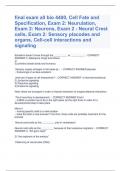
-
final exam all bio 4400, Cell Fate and Specification, Exam 2: Neurulation, Exam 2: Neurons, Exam 2 - Neural Crest cells, Exam 2: Sensory placodes and organs, Cell-cell interactions and signaling
- Exam (elaborations) • 95 pages • 2024
-
- $13.49
- + learn more
final exam all bio 4400, Cell Fate and Specification, Exam 2: Neurulation, Exam 2: Neurons, Exam 2 - Neural Crest cells, Exam 2: Sensory placodes and organs, Cell-cell interactions and signaling Ectoderm doesn't move through the __________ or __________ - CORRECT ANSWER 1) blastopore (frogs and fishes) or 2) primitive streak (birds and humans) Sensory organs all begin in the head as... - CORRECT ANSWER placode - thickenings of surface ectoderm what are 4 types of cell interact...

-
OSMT Exam Questions with verified Solutions 100% Solved 2024
- Exam (elaborations) • 10 pages • 2024
- Available in package deal
-
- $12.49
- + learn more
OSMT Exam Questions with verified Solutions 100% Solved 2024 Why doesn't phylogenetic systematics have a fixed number of hierarchical categories like Linnaean systematics? - answerEach branching point is a hierarchical level in the nested structure of phylogenetic systematics. The number of branching points—and therefore the number of possible hierarchical levels—varies substantially from one lineage to another. What aspect of evolution does phylogenetic systematics represent more c...

-
CSET SUBTEST II: SCIENCE 100% SOLUTIONS
- Exam (elaborations) • 52 pages • 2023
-
- $11.49
- + learn more
CSET SUBTEST II: SCIENCE 100% SOLUTIONS Morphogenesis - ANSWER When cells divide, the cell will change shape/organization many times by going through a succession of stages -A single-celled egg develops into a complex, multi-cellular organism by dividing and going through many stages in this process Order of Embryological Development - ANSWER Morula-->Blastula-->Gastrula-- >Neurla Zygote-Cleavage--Morula-Blastula, Gastrula, Neurla, Organogenesis Fertilization triggers the...
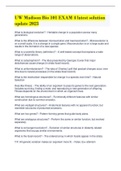
-
UW Madison Bio 101 EXAM 4 latest solution update 2023.
- Exam (elaborations) • 5 pages • 2023
- Available in package deal
-
- $11.49
- + learn more
What is biological evolution? - Heritable change in a population across many generations. What is the difference between microevolution and macroevolution? - Microevolution is on a small scale. It is a change in a single gene. Macroevolution is on a large scale and results in the formation of a new species. What is a scientific theory (definition)? - A well-tested concept that explains a wide range of observations. What is catastrophism? - The idea presented by Georges Cuvier that major...
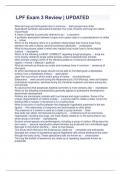
-
LPF Exam 3 Review | UPDATED
- Exam (elaborations) • 2 pages • 2023
-
- $8.99
- + learn more
LPF Exam 3 Review | UPDATED What do fungi and arthropods have in common - both groups have chitin Specialized symbiotic associations between the roots of plants and fungi are called - mycorrhizae A mass of hyphae is commonly referred to as - a mycelium A symbiotic association between fungus and a green alga or a cyanobacterium is called a - lichen Which of the following refers to a symbiotic relationships that involve fungi living between the cells in plants (several synthesize al...
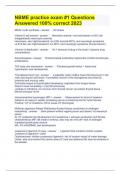
-
NBME practice exam #1 Questions Answered 100% correct 2023
- Exam (elaborations) • 17 pages • 2023
-
Available in package deal
-
- $22.49
- + learn more
NBME practice exam #1 Questions Answered 100% correct 2023 Mitotic cyclin synthesis G2 phase Vitamin E def anemia Hemolytic anemia~ red antioxidants vs B12 def (megaloblastic macrocytic anemia) Hemolysis~ dec Hgb/hematocrit, inc LDH (normal MCV), and neurologic symptoms vs B12 def: dec Hgb/hematocrit, inc MCV, and neurologic symptoms (dorsal column) Volume of distribution Vd = (amount of drug in the body) / (plasma drug concentration) Achondroplasia Endochondria...

-
UPDATED 2024 CSET SUBTEST II: SCIENCE 100% SOLUTIONS
- Exam (elaborations) • 52 pages • 2024
-
- $11.49
- + learn more
Morphogenesis - ANSWER When cells divide, the cell will change shape/organization many times by going through a succession of stages -A single-celled egg develops into a complex, multi-cellular organism by dividing and going through many stages in this process Order of Embryological Development - ANSWER Morula-->Blastula-->Gastrula-- >Neurla Zygote-Cleavage--Morula-Blastula, Gastrula, Neurla, Organogenesis Fertilization triggers the zygote to go through a series of rapid cell div...

Study stress? For sellers on Stuvia, these are actually golden times. KA-CHING! Earn from your study resources too and start uploading now. Discover all about earning on Stuvia


